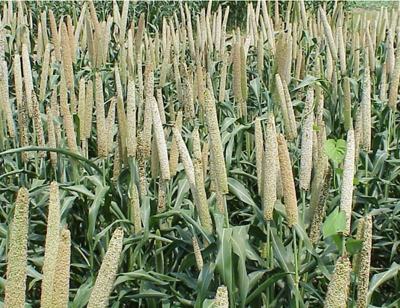
TifGrain 102 pearl millet in the grain filling stage.
Dewey Lee1
Wayne Hanna1
G. David Buntin1
William Dozier1
Patricia Timper 1
Jeffrey P. Wilson1
Introduction
Pearl millet (Pennisetum glaucum [L.] R. Br.) has a long history of use as a summer grazing and hay crop in the southeastern United States. The recent development of new, adaptable and productive grain pearl millet hybrids in the southeast gives crop producers a suitable alternative feed grain for dryland production.
Pearl millet is one of the most drought resistant grains in commercial production. It is able to grow in areas that experience frequent periods of dry weather during either the vegetative or reproductive phases.
Pearl millet appears to be more tolerant of sandy and acidic soils than other summer grain crops. It is deep-rooted and can use residual nitrogen, phosphorus and potassium and, therefore, may not need the levels of fertility required by other summer grains. These characteristics enhance pearl millet's desirability in lower input, dryland production systems.
On-farm demonstrations and research have shown that pearl millet can reliably produce yields of 70 or more bushels of grain per acre with careful management. Severe drought reduces yields of pearl millet, but the plant is capable of withstanding periods of drought that would cause greater yield reductions or crop failure in other summer grain crops. It is well suited for double cropping behind small grains and vegetables.
The grain can be used in poultry, cattle and swine rations without adversely affecting feed efficiency or weight gain. Total metabolizable energy of pearl millet is similar to corn. Crude protein levels in pearl millet range from 12 to 14 percent.
Growth Habits and Requirements
Pearl millet is a summer annual crop well-suited for double cropping and rotations.
It germinates well at soil temperatures of 75 to 90 degrees F. Emergence occurs in 2 to 4 days under favorable conditions. Seedling development occurs during the first two to four weeks, and rapid stalk development occurs soon after. Tillering may be extensive in sparse stands, particularly if good soil moisture is available. Flowering usually begins at 40 to 50 days after emergence, and the plant reaches physiological maturity by 75 to 85 days after emergence. Growth and maturation are usually hastened with late plantings.
Pearl millet can be grown on a wide variety of soils ranging from clay loams to deep sands. Yields and grain quality, however, are best on deep, well-drained productive soil. Soil management and tillage that encourages deep rooting generally enhance yields and seed quality. Do not grow millet on soils prone to "water logging" in wet seasons. Doing so will cause shallow rooting, low seed protein and poor yields.
Irrigation can improve stand establishment if soil is dry during and after seeding. Little is known about pearl millet response to irrigation during growth. It appears that pearl millet responds less to irrigation than other grain crops. Greatest water use occurs during the bloom and soft dough stages. A very deep root system and less defined "critical water use period" makes pearl millet tolerant of short duration drought.
Recommended Cultural Practices
Varieties
A new hybrid, TifGrain 102, has been cooperatively developed and released by the USDA-ARS and the University of Georgia at Tifton. Seed harvested from a hybrid will not produce a uniform or productive crop the following year. Therefore, new seed will have to be purchased annually to obtain high yields associated with hybrid vigor. Other hybrids suitable for grain production in the southeastern United States continue to be developed. Hybrids developed for use in other regions have not been evaluated in the southeast, so their performance is not known.
Several forage pearl millet hybrids are available for purchase. Most, however, will not develop grain. Be sure to plant only those hybrids developed for grain production if your intention is to produce a grain crop.
Planting Date
Do not begin early plantings until soil temperatures at the 2-inch depth are at least 70 degrees F. Planting in cooler soils will cause problems with reduced emergence and greater competition from weeds.
For economical grain production, pearl millet can be planted in the Piedmont area from May 1 to July 15. In the Coastal Plain, planting can be extended to August 10 under ideal conditions. We have observed better performance at the earlier planting dates, which often avoid the lengthy summer droughts that can occur in Georgia. Plantings for wildlife can be established until the end of August in the Coastal Plain areas.
Seed Bed Preparation
Optimum stand establishment is obtained when a weed-free, firm seedbed is prepared. Prepare the soil and seedbed similar to that for other summer crops. Deep till or in-row subsoil sandy textured soils to disrupt any hard pans. No-till or conservation-tillage plantings can be successful and are desirable on highly erodible land or clayey soils. This will reduce soil erosion and enhance stand establishment due to better seed depth control in firmer soils. Control emerged weeds prior to planting. If no-tilling in the spring, deep tillage ahead of the winter cover crop in the fall is preferred. However, reconstitution of the hardpan in sandy soils can occur, particularly if good rainfall occurs during the winter.
Seeding Rates
Use precision planters or grain drills capable of planting 2 to 5 pounds of seed/acre (Table 1). Pearl millet tillers profusely and can make up for large skips within the rows without suffering severe yield losses. A plant every 3 to 4 inches can give excellent yield results with good management practices. While it is difficult to obtain low seeding rates, seeding rates of 4 to 5 lbs/acre don't appear to be detrimental to yield. Populations of 150,000 to 200,000 plants per acre are more than sufficient for good grain yields. Any planter and plates that place seed 1 to 2 inches apart, such as air or vacuum planters, should provide good results.